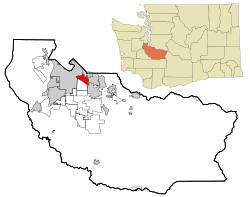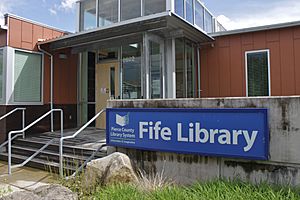Fife, Washington facts for kids
Quick facts for kids
Fife, Washington
|
|
|---|---|

Location of Fife, Washington
|
|
| Country | United States |
| State | Washington |
| County | Pierce |
| Founded | 1899 |
| Incorporated | February 11, 1957 |
| Named for | William J. Fife |
| Government | |
| • Type | Council–manager |
| Area | |
| • Total | 5.96 sq mi (15.45 km2) |
| • Land | 5.83 sq mi (15.11 km2) |
| • Water | 0.13 sq mi (0.34 km2) |
| Elevation | 16 ft (5 m) |
| Population
(2020)
|
|
| • Total | 10,999 |
| • Estimate
(2023)
|
10,723 |
| • Density | 1,838.11/sq mi (709.69/km2) |
| Time zone | UTC–8 (Pacific (PST)) |
| • Summer (DST) | UTC–7 (PDT) |
| ZIP Code |
98424
|
| Area code(s) | 253 |
| FIPS code | 53-23795 |
| GNIS feature ID | 1512206 |
Fife is a city in Washington state, located in Pierce County. It's like a neighbor to the bigger city of Tacoma. In 2020, about 11,000 people lived there. Fife is special because it's part of the Puyallup Indian Reservation and has a major highway, Interstate 5, running right through it. It's also close to the Port of Tacoma.
Contents
History of Fife
Early History and the Puyallup People
The land where Fife is today was originally home to the Puyallup people. They lived in the lower Puyallup River basin for a very long time. After the Medicine Creek Treaty was signed in 1854, the Puyallup people's lands were changed. This treaty created the Puyallup Indian Reservation, which grew to include the area that is now Fife.
Later, some of this land was lost due to laws like the General Allotment Act in 1887. However, a special agreement in 1990 helped resolve these land claims.
How Fife Got Its Name
The first non-Native American settlers arrived in the late 1890s. The city of Fife might have been named after William J. Fife. He was a well-known lawyer from Tacoma, a gold prospector in the Yukon, and a leader in the Washington National Guard.
Another idea is that the city was named after Fife, a historic county in Scotland. This area in Scotland was once a kingdom of the Picts.
Fife in the Past
In 1940, Fife was described as a small town with markets, shops, and a large dance hall. It was in a valley known for growing berries and other crops. At that time, only about 135 people lived there.
Fife also had a large Japanese American community. Sadly, during World War II, many Japanese American residents were forced to leave their homes and go to internment camps. This happened because of a government order called Executive Order 9066.
Becoming an Official City
Fife officially became a city on February 11, 1957. About 850 people lived there at the time. The main reason Fife became a city was to stop the bigger city of Tacoma from taking over its business areas. It also helped the community get its own unique identity.
Joe Vraves was elected as Fife's first mayor. He served as mayor until 1981. The main highway, U.S. Route 99, was replaced by Interstate 5 (I-5). This new freeway opened in Fife on October 10, 1962. The opening of I-5 brought many new businesses to Fife, especially those for travelers. This helped the city earn a lot of money from sales tax.
Economy of Fife
Fife is a busy place with many businesses. It's located just east of Tacoma. You'll find lots of car dealerships, warehouses, and industrial buildings here. There are also motels, drive-through shops, and quick-dining restaurants.
A Native American casino is also a big part of Fife's economy. Because Fife is close to the Port of Tacoma, Interstate 5, and Highway 167, many companies that move goods and freight are located here. The city gets its money from sales tax, utility tax, and property tax.
Fife Heights is a nearby area on a hill, mostly made up of homes. The cities of Milton and Edgewood are also close by.
Geography of Fife
Fife is located entirely within the Puyallup Indian Reservation. However, most of the land is owned by people who are not Native American. The city covers about 5.96 square miles (15.45 square kilometers). Most of this area is land, with a small part being water.
Tideflats and Water Levels
Fife is known as a "tideflat community." This means it's in a low, flat area that stretches from the Port of Tacoma. Because of this, the water table (the level of water under the ground) is very close to the surface, sometimes only 10 to 15 feet (3 to 4.5 meters) down.
This also means that as the tide rises and falls in the Puget Sound during the day, parts of the land in Fife can slightly rise and fall too!
Flood Risk
The southern parts of Fife are in the floodplain of the Puyallup River. This means these areas could be flooded if the river overflows. Also, much of the city could be damaged if a lahar (a type of mudflow) were to happen from an eruption of Mount Rainier.
Population and People of Fife
| Historical population | |||
|---|---|---|---|
| Census | Pop. | %± | |
| 1960 | 1,463 | — | |
| 1970 | 1,458 | −0.3% | |
| 1980 | 1,823 | 25.0% | |
| 1990 | 3,864 | 112.0% | |
| 2000 | 4,784 | 23.8% | |
| 2010 | 9,173 | 91.7% | |
| 2020 | 10,999 | 19.9% | |
| 2023 (est.) | 10,723 | 16.9% | |
| U.S. Decennial Census 2020 Census |
|||
In 2022, there were about 4,011 households in Fife. On average, about 2.7 people lived in each home. The average income for a household in Fife was about $84,538 per year. About 11.7% of the people in Fife lived at or below the poverty line.
About 73.4% of the people in Fife who can work have jobs. Also, 25.6% of the population has a college degree or higher, and 88.2% have a high school diploma.
Diversity in Fife
Fife is a diverse city with people from many different backgrounds. Here's a look at the different groups living in Fife, based on the 2020 census:
| Race / ethnicity (NH = non-Hispanic) | Pop. 2000 | Pop. 2010 | Pop. 2020 | % 2000 | % 2010 | % 2020 |
|---|---|---|---|---|---|---|
| White alone (NH) | 3,049 | 4,406 | 4,341 | 63.73% | 48.03% | 39.47% |
| Black or African American alone (NH) | 312 | 726 | 1,106 | 6.52% | 7.91% | 10.06% |
| Native American or Alaska Native alone (NH) | 182 | 221 | 236 | 3.80% | 2.41% | 2.15% |
| Asian alone (NH) | 302 | 1,400 | 1,707 | 6.31% | 15.26% | 15.52% |
| Pacific Islander alone (NH) | 58 | 248 | 852 | 1.21% | 2.70% | 7.75% |
| Other race alone (NH) | 7 | 15 | 55 | 0.15% | 0.16% | 0.50% |
| Mixed race or multiracial (NH) | 226 | 562 | 1,025 | 4.72% | 6.13% | 9.32% |
| Hispanic or Latino (any race) | 648 | 1,595 | 1,677 | 13.55% | 17.39% | 15.25% |
| Total | 4,784 | 9,173 | 10,999 | 100.00% | 100.00% | 100.00% |
In 2020, the population of Fife was 10,999 people. About 24.8% of residents were under 18 years old. The average age in the city was 32.5 years. About 47.7% of the population was female.
Education in Fife
Most of Fife is part of the Fife Public Schools district. This school district also includes the nearby towns of Milton and parts of Edgewood. The district has one high school, Fife High School.
Some other parts of Fife are in the Puyallup School District.
Notable People from Fife
- Dr. Mark Emmert – He used to be the president of the University of Washington and also led the National Collegiate Athletic Association (NCAA).
- Frank Herbert – A famous author, best known for writing the Dune series of books.
- Kaleb McGary – An American football player who plays as an offensive tackle for the Atlanta Falcons.
See also
 In Spanish: Fife (Washington) para niños
In Spanish: Fife (Washington) para niños


